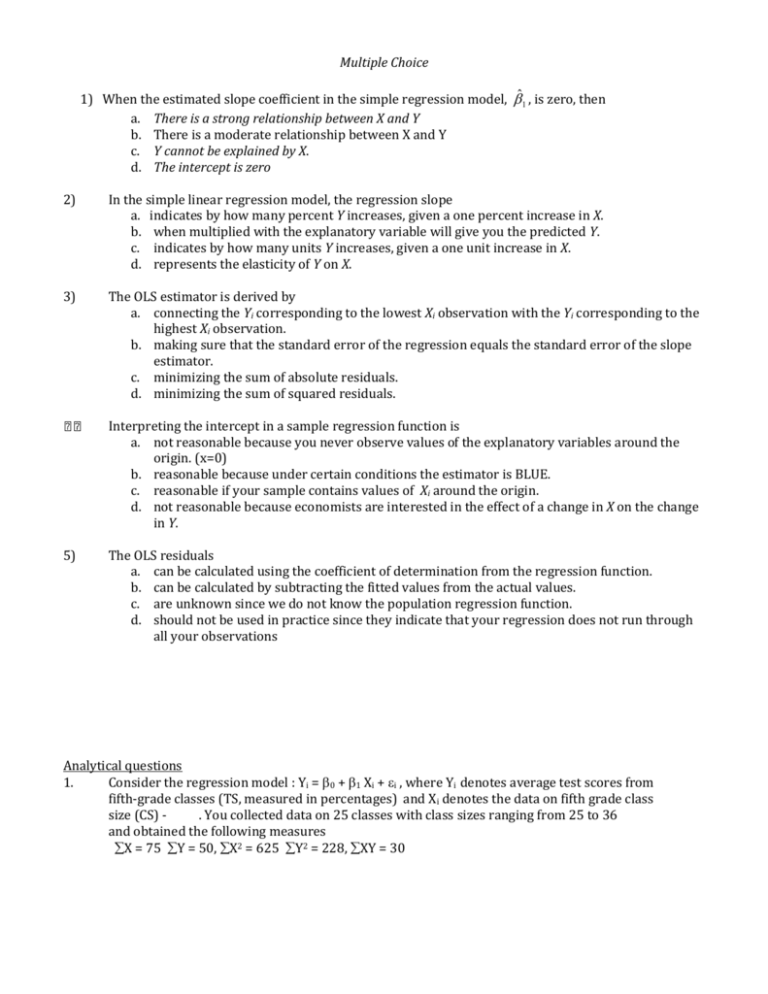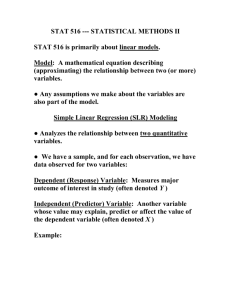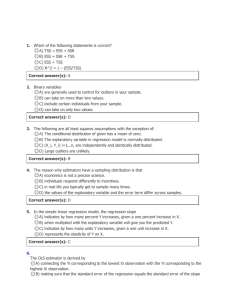Problem set #2A
advertisement

Multiple Choice 1) When the estimated slope coefficient in the simple regression model, ̂ 1 , is zero, then a. There is a strong relationship between X and Y b. There is a moderate relationship between X and Y c. Y cannot be explained by X. d. The intercept is zero 2) In the simple linear regression model, the regression slope a. indicates by how many percent Y increases, given a one percent increase in X. b. when multiplied with the explanatory variable will give you the predicted Y. c. indicates by how many units Y increases, given a one unit increase in X. d. represents the elasticity of Y on X. 3) The OLS estimator is derived by a. connecting the Yi corresponding to the lowest Xi observation with the Yi corresponding to the highest Xi observation. b. making sure that the standard error of the regression equals the standard error of the slope estimator. c. minimizing the sum of absolute residuals. d. minimizing the sum of squared residuals. Interpreting the intercept in a sample regression function is a. not reasonable because you never observe values of the explanatory variables around the origin. (x=0) b. reasonable because under certain conditions the estimator is BLUE. c. reasonable if your sample contains values of Xi around the origin. d. not reasonable because economists are interested in the effect of a change in X on the change in Y. 5) The OLS residuals a. can be calculated using the coefficient of determination from the regression function. b. can be calculated by subtracting the fitted values from the actual values. c. are unknown since we do not know the population regression function. d. should not be used in practice since they indicate that your regression does not run through all your observations Analytical questions 1. Consider the regression model : Yi = 0 + 1 Xi + i , where Yi denotes average test scores from fifth-grade classes (TS, measured in percentages) and Xi denotes the data on fifth grade class size (CS) . You collected data on 25 classes with class sizes ranging from 25 to 36 and obtained the following measures X = 75 Y = 50, X2 = 625 Y2 = 228, XY = 30 a. What does the term I represent? b. Find the estimated regression equation and interpret it fully. d. A classroom has 22 students. What is the regression prediction for the classroom’s average test score? Is this prediction reliable? Why or why not? c. The sample average class size across the 25 classrooms is 5. What is the average test scores across the 25 classrooms? 2. Sir Francis Galton, a cousin of James Darwin, examined the relationship between the height of children and their parents towards the end of the 19th century. It is from this study that the name “regression” originated. You decide to update his findings by collecting data from 110 college students, and estimate the following relationship: Studenth = 19.6 + 0.73×Midparh, R2 = 0.45, Se = 2.0 where Studenth is the height of students in inches, and Midparh is the average of the parental heights. (Following Galton’s methodology, both variables were adjusted so that the average female height was equal to the average male height.). SER is the standard error of regression (a) (b) Interpret the estimated equation. Is the estimated intercept meaningful? Why or why not. Given the positive intercept and the fact that the slope lies between zero and one, what can you say about the height of students who have quite tall parents? Who have quite short parents?










